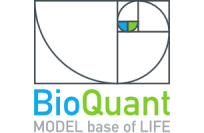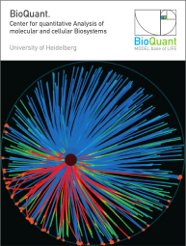Research Training Group: Mathematical Modeling for the Quantitative Biosciences (MMQB)
Mathematical modeling of the two-faced role of immune cells at the crossroad of skin cancer and wound healing - BioQuant_Grabe0116
Supervisor: apl. Prof. Dr. Niels Grabe (BioQuant & NCT)
Experimental Partners: Prof. Dr. Alexander Enk (Dermatology, Medical Faculty), Prof. Dr. Joachim Spatz (Max-Planck-Institute for Medicine Heidelberg)
Background and scientific question:
Wound healing is one of the most fundamental and most complex basic biological processes in all living systems. Recently we have uncovered the general mechanism of wound closure, i.e. how cell streaming realizes wound closure in a collective, emergent phenomenon in an organotypic in vitro wound model. In doing so, we identified the extending shield mechanism (ESM), which is realized by collective cell migration and leads to the cell-by-cell reconstruction of the 3D structure of the epidermis (Nature Cell Biology 2015). We then elucidated the underlying molecular mechanisms responsible for guiding the collective migration of a 2D epithelial cell sheet (Nature Cell Biology 2015). Cancer, on the other hand, can be considered in many ways as the degeneration of this process. In previous work, we have pioneered the computational analysis of immune infiltrates on microscopic digital whole slides resulting in novel spatial data sets (Cancer Research 2011). Recently, new immune cell based therapies (e.g. PD-L1, PD1, CTLA4 or cancer vaccines) have become available offering cancer patients for the first time the chance of stable disease. However, their success depends on specific spatial collective patterns of immune cell populations (e.g. CD3, CD4, CD8), called the “immune contexture”. We will analyze this immune contexture on the basis of the example of skin wound healing and skin cancer and compare both situations. In both processes, certain immune cell populations (e.g. CD3, CD4, CD8) directly influence both processes in opposite ways. Understanding their two-faced role requires a quantitative, spatial and mathematical approach. Based on previous work, this project will perform a systematic spatial-quantitative analysis and modeling of immune cell behavior by integrating cellular imaging and cytokine measurements. To this end, we have established a close collaboration in previous work with Alexander Enk (Dermatology Department University Hospital Heidelberg) and Joachim Spatz (Max-Planck- Institute for Medicine, Heidelberg).
Project goal:
Based on our previous work, this project will perform a systematic spatial-quantitative analysis and mathematical modelling of immune cell behavior in skin cancer and wound healing. This way, we will obtain a quantitative understanding of the individual immunological situation of cancer patients. That will help to select individual patients suitable for specific immunotherapies as well as identifying early positive or negative responses of patients to certain forms of treatments. Specific biomaterials can then be designed shifting these immune cell contextures through cytokine exposure towards desirable states and, as a result, supporting therapeutic success.
Planned work and collaboration within the RTG:
The RTG including its external collaboration partners has important distributed knowledge on all of the relevant scientific fields involved. The group of Alexander Enk will provide patient samples and skinpathological analysis of patients from recent immunotherapeutic trials as well as from wound healing as well as cytokine data. Research question: “What are the patient individual profiles look like?”. Profiling will be performed also together with the Institute of Pathology. The group of Joachim Spatz will provide experimental samples 3D tissue cultures exposed to immunomodulatory cytokine profiles to answer the question: “How can those profiles be rationally shifted?”. Together with the groups of Thomas Höfer and Ursula Kummer we will interact on the molecular networks underlying immune cell models (Question: “How are cytokines influencing the immune cell networks?”). The technical platforms of the Kummer and Grabe groups have already published an interface for tissue-scale modeling. To this end we use live-cell imaging data obtained within 3D cell culture systems, whole-slide immune-histological biomarker data from clinical specimen as a phenotypic pathological read-out, and cytokine data as global tissue regulators measured on the molecular level. These experimental data provided by the partners in established experimental systems provide a comprehensive data set holding important keys to understanding the immune contexture of successful cancer therapy and skin regeneration. EPISIM platform (Bioinformatics 2013). The theoretical aspects of spatial modelling on the tissue-scale are integrated with works of the groups of Ulrich Schwarz and Anna Marciniak-Czochra.
List of relevant publications:
1. Das T, Safferling K, Rausch S, Grabe N, Boehm H, Spatz JP. Nat Cell Biol. 2015 17(3): 276-87.
2. Safferling K, Sütterlin T, Westphal K, Ernst C, Breuhan K, James M, Jaeger D, Halama N, Grabe
N. Journal of Cell Biology 25, 2013.
3. Suetterlin T, Kolb C, Dickhaus H, Jaeger D, Grabe N. Bioinformatics 2013 29(2): 223-9.
4. Halama N, Michel S, Kloor M, Zoernig I, Benner A, Spille A, Pommerencke T, von Knebel DM,
Folprecht G, Luber B, Feyen N, Martens UM, Beckhove P, Gnjatic S, Schirmacher P, Herpel E,
Weitz J, Grabe N, Jaeger D. Cancer Res. 2011 71(17): 5670-77.
Application: If you would like to apply for one of these PhD research projects, please click here and follow the instructions on the HBIGS website.


